Thursday, 5th May 2022
RBI increases repo rate
In News
Reserve Bank of India’s Monetary Policy Committee has hiked the repo rate by 40 basis points, taking it to 4.40 per cent under the Liquidity Adjustment Facility with immediate effect.
Decisions made by MPC
- Reserve Bank of India increased the Repo rate, the main policy rate, by 40 basis points to 4.40 per cent in an unscheduled meeting of the MPC.
- The cash reserve ratio (CRR) has been increased by 50 basis points to 4.50 per cent to suck out liquidity and bring down the elevated inflation.
- However, the central bank retained the accommodative monetary policy, only withdrawing the excess accommodation done during Covid response policy move.
Why has the repo rate been increased?
- By hiking the Repo rate and CRR, RBI is aiming to keep inflation, which is already close to 7 %.
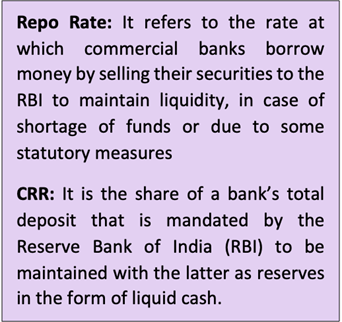
-
- According to the inflation targeting of the government, inflation rate should be maintained in the range 2-6%.
- The MPC has acknowledged that the overall outlook for inflation has darkened considerably since it met last month.
- Prices are rising globally and inflationary pressures are broadening worldwide.
- The IMF last month posited that the war in Ukraine was poised to not only slow global growth in 2022 but would also cause inflation to accelerate by 2.8 percentage points in the case of emerging market and developing economies.
- With central banks in advanced economies pursuing a path of policy normalisation, the volatility in capital flows adding pressure on the exchange rate causes the risk of imported inflation.
- Sustained high inflation hurts savings, investment, competitiveness and output growth. It has pronounced adverse effects on the poorer segments by eroding their purchasing power.
- Also, the rise in Covid cases in China has triggered the fear of a fresh wave of infections. This may lead to uncertainty and cause inflationary forces to strengthen.
How does the Repo rate and CRR hike affect the economy?
- The hike in Repo rate – the key policy rate of RBI or the rate at which it lends to banks – means the cost of funds for banks will go up.
- This will prompt banks and NBFCs to raise the lending and deposit rates in the coming days.
- SBI and many banks recently raised the MCLR (marginal cost of funds-based lending rate) points anticipating a rate hike
- However, analysts say that consumption and demand can be impacted by the Repo rate hike.
- The hike in CRR will suck out liquidity from the banking system. The lendable resources of banks will come down accordingly.
- It also means the cost of funds will go up and banks’ net interest margins could get adversely impacted.
- If the RBI wants to infuse more liquidity into a system, it lowers the CRR and leaves banks with more liquidity to lend. If the RBI wants to suck out liquidity from the system, it increases the CRR rate.
- High liquidity in the system leads to inflationary forces to act.
- Both the equity and debt markets reacted negatively to the sudden development and yield curve is expected to shift upwards (slightly more impact at the shorter end of the curve).
Sources:
- EMIs set to rise as RBI hikes repo rate by 40 bps to 4.40%
- RBI Monetary Policy Review - Hike In The Repo Rate, CRR Much Required At This Point
- Mutual fund managers react to RBI’s surprise rate hike
- Explained: Your EMIs are set to go up; why has RBI suddenly raised Repo rate by 40 bps?
- Inevitable increase: On RBI’s interest rate hike
Global Security Initiative
In News
Amid Ukraine war, China has proposed the “Global Security Initiative”
About the News
- Chinese president Xi Jinping has recently outlined a six-point proposal for global security which broadly confirms China’s stand on Russia’s war against Ukraine to protect what Moscow states its security interests against Kyiv joining the NATO alliance.
- The new initiative is aimed at securing the sovereignty of all Asian countries and deemed as a veiled attack on the United States’ forays into the region with the Indo-Pacific strategy.
- Previously, china has been critical of the U.S.’ Indo-Pacific strategy to assert the freedom of navigation opposing Beijing’s aggressive expansion in the disputed South China Sea
What are the major highlights of the proposal?
- Sovereignty: Countries should respect the sovereignty and territorial integrity of all countries, uphold non-interference in internal affairs.
- Diversity: Countries should respect the independent choices of development paths and social systems made by people in different countries.
- Security: The countries should stay committed to taking the legitimate security concerns of all countries seriously, uphold the principle of indivisible security, build a balanced, effective, and sustainable security architecture, and oppose the pursuit of one's own security at the cost of others' security.
- Conflict resolution: Countries should peacefully resolve differences and disputes between countries through dialogue and consultation, support all efforts conducive to the peaceful settlement of crises, reject double standards, and oppose the wanton use of unilateral sanctions and long-arm jurisdiction.
- Regional disputes: The counties should maintain security in both traditional and non-traditional domains, and work together on regional disputes and global challenges such as terrorism, climate change, cybersecurity, and biosecurity.
- Co-existence: No matter their size and strength, the countries both in and outside the region should add splendour rather than trouble to Asia.
Why is the initiative important for china?
- Countering US influence: The initiative is seen as attempt to counter the U.S. scheme of galvanising nations in the Indo-pacific region against Beijing’s aggressive expansion in the disputed South China Sea.
- Countries including Vietnam, the Philippines, Malaysia, Brunei, and Taiwan have counterclaims over the South China Sea.
- Countering regional alliances: China opposes the Quad alliance comprising the U.S., India, Australia, and Japan as well as the AUKUS alliance of the U.S., Australia and the U.K. which Beijing asserts is aimed at curbing its rise.
Sources:
Internet shutdowns in India
In News
According to the recent data by tech policy think tank-Access Now, India has recorded the highest number of internet shutdowns in the world in 2021, for the fourth consecutive year.
About the News
- The data has denoted that as many as 106 of the 182 internet clampdowns registered globally were in India.
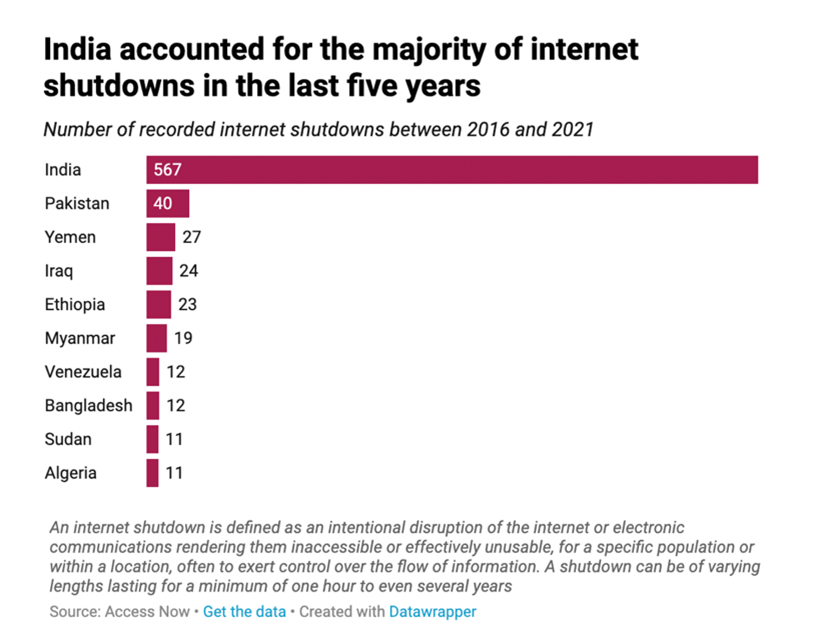
-
- Internet shutdown is defined as an intentional disruption, making the internet or electronic communications inaccessible or effectively unusable for at least an hour.
- Authorities in many countries impose such shutdowns to suppress dissent, silence critics, and control the flow of information during elections.
- The global count of such shutdowns had dipped in 2020 due to the pandemic, but rose again in 2021.
- J&K had the highest number of internet blackouts in India since such data became available. In 2021 as well, out of the 106 shutdowns, 85 were imposed in J&K.
- It finally ended in February 2021 after 4G data services were restored across J&K after 550 days.
- Blockades were also recorded in the National Capital Region of Delhi and parts of Haryana during protests by farmers against a set of controversial laws that have since been repealed.
Economic and Social Ramifications of Internet shutdowns
- Economic Cost: They have been estimated to cost India around $583 million in 2021 alone. Brookings study had estimated that India lost around $968 million due to shutdowns between July 2015 and June 2016.
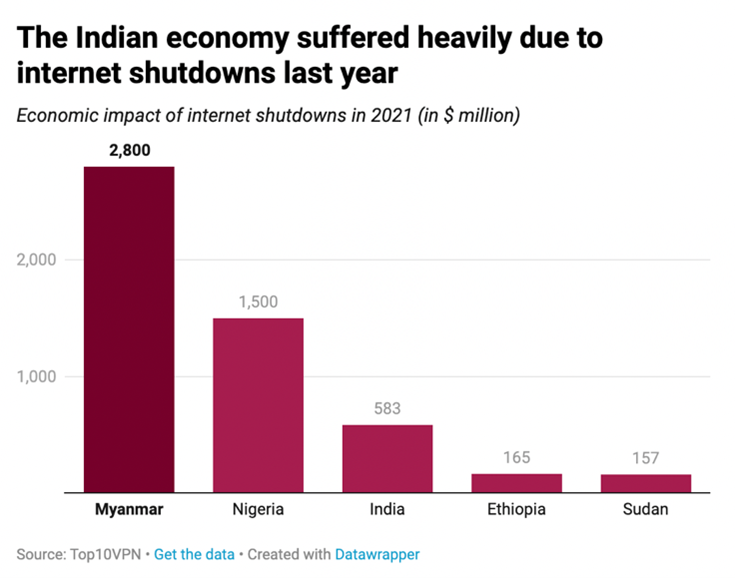
- Social Cost: The long internet shutdown in J&K overlapped with the first wave of covid-19, affecting access to healthcare and education.
- Quarantined patients could reportedly not get in touch with families, contact-tracing efforts were hindered and doctors struggled to communicate.
- Online classes were difficult due to curtailed bandwidth.
- Counterproductive Effect: While there is little evidence to prove that internet shutdowns serve the intended purposes of restoring peace, stop misinformation and curb terrorism, studies have shown that they often have the opposite effects.
- The United Nations’ Human Rights Office has also observed that in situations of conflict and unrest, internet disruptions “exacerbate risks of further violence and insecurity".
- The South-Asia Terrorism Portal recorded a spike in terror-related incidents in J&K in the two years after Article 370 was abrogated.
Way Forward
- The Supreme Court, in 2020 had declared access to the internet as a fundamental right.
- Though the government claims that most of these shutdowns were ordered for counter-terrorism measures, to quell unrest and keep anti-national elements at bay, experts and activists feel that, “An internet shutdown cannot be justified in any situation as it has a disproportionate impact on fundamental rights,"
Source:
Image source:
Surendranath Banerjee
On May 5, 1883, Surendra Nath Banerjee became the first journalist to go to jail. He was also given the title of Rashtra Guru. Sir Surendranath Banerjee was one of the earliest Indian political leaders during the British Raj. He founded the Indian National Association, one of the earliest Indian political organisations, and later became a senior leader of the Indian National Congress.

Banerjee was born on November 10, 1848, and died on August 6, 1925. He was the second Indian to qualify the Indian Civil Service examinations, and was appointed to a post in Sylhet in his homeland; however, in 1874 he was dismissed for a minor and apparently inadvertent procedural error. Banerjee was knighted by the British in 1921. He founded the English language newspaper, The Bengali.
Source:
Military Spending Optimization
In News
India's military expenditure increased to USD 76.6 billion in 2021, according to a report released by defence think-tank Stockholm International Peace Research Institute (SIPRI).
About the News
- India's spending was up by 9 per cent from 2020 and by 33 per cent from 2012.
- Amid ongoing tensions and border disputes with China and Pakistan that occasionally spill over into armed clashes, India has odernizati the odernization of its armed forces and self-reliance in arms production.
- In a drive to strengthen the indigenous arms industry, 64 per cent of capital outlays in the 2021 Indian military budget was earmarked for acquisitions of domestically produced arms.
India’s Defence Budget
- For the last few years, India’s defence budget has been hovering at around two per cent as a percentage of the GDP. One third of government’s capital expenditure goes towards the military.
- Unless India’s economy grows by 12% every year, any further increase in the defence odernization budget would lead to a virtual stalling of all infrastructure projects.
- India is already the world’s third-largest military spender, behind the US and China, and the world’s second largest importer of arms. India also has an ample stockpile of nuclear warheads and ballistic missiles.
- The security situation on the northern borders, the continuing inimical relationship with our western neighbour and the increased deployment in the Indian Ocean to ensure maritime security, are being highlighted as the factors leading to a robust financial outlay for defence.
Need for Optimization of Military Spending
- For Modernization of Armed Forces: Keeping in view the urgent need to modernise the armed forces, military planners have been seized with the requirement of better management of the budget to find more money for capital expenditure.
- At 40%, the Chinese People’s Liberation Army (PLA) spends nearly double the amount on capital expenditure in percentage terms than India does. With two adversaries on borders, India cannot afford to continue the in the same vein.
- High Salaries and Pension Spending: Measures are needed to reduce pension and salary bills, which account for nearly 50 per cent of the defence budget. Such high expenditure leaves little money to modernise the force and serve equipment shortfalls.
- High Manpower problems: As military manpower becomes expensive to recruit, train and retain, the military can opt for technological solutions at least in low-risk areas and relying more on ‘mean and lean’ conventional forces for deterrence.
- Bettering of Logistics: Due to the peculiarity of terrain, deployment, and type of challenges on un-demarcated borders, the Army combat components remain human resource intensive. It would be prudent to focus increasingly on outsourcing of logistics and services wherever possible, to cut down on the revenue bill.
- What seems to be lacking is a clear perception of desired capabilities, linked to timelines, to meet the security challenges that may confront the nation, in at least a medium time-frame of 7-10 years. The defence budget has to be capability-driven and not intention-driven.
Steps needed to bring in Optimization of Defence Expenditure
Ex- Chief of Defence Staff (CDS) General Bipin Rawat and the Service chiefs has endeavoured to optimise the utilisation of the defence budget by reducing the revenue expenditure to correspondingly increase the capital expenditure. The Army came up with a slew of proposals in this regard in its report — Optimization of Manpower and Resources: Review of Practices and Facilities in Indian Army.

Problems with these Suggestions
- These suggestions seem to be missing is a top-down holistic long-term approach, based on a strategic review. These are, at best, short-term incremental measures that, in some cases, also tend to impinge on the ethos and functional efficiency of the armed forces.
- Some of these proposals will also have an adverse effect on the attraction of the armed forces as an elite organization with in-built perks and privileges financed out of regimental (quasi private) funds. In some cases, the proposals impinge on fundamental issues such as maintaining a young profile and stagnation in promotions.
- There are also reservations about whether this is the right time to begin downsizing. India's hostile borders mean the army needs to be always prepared to fight two simultaneous land wars against nuclear-armed rivals, Pakistan, and China.
- A hiring freeze at a time when we have unsettled borders across demanding terrain could adversely impact manpower availability in immediate terms.
- Today’s wars and battles have no definitive war or battle zones when nations are armed with missiles or aircraft that can hit thousands of miles away. In fact, support zones where supply and equipment management echelons are deployed become priority and attractive targets since such strikes can cripple the enemy’s initiatives and capabilities in many ways. Therefore, it becomes imperative to have support echelons well trained in many aspects of warfare since they are highly susceptible to enemy strikes.
Way Forward
- The first is a change of culture or a change of mindset. This would involve not just a willingness to accept a new structure in the military hierarchy– doing away with divisions, for example – but also mean using new signs of respect for soldiers through the ranks.
- The defence budget is often seen as a necessary drain on the exchequer. With an emphasis on high-quality indigenous defence production, both by private players and efficiently managed defence public sector undertakings, it can be transformed into an engine of economic growth.
- Organizational restructuring in militaries is an important element of revolution in military affairs (RMA). But that cannot be the first step. RMA must address the changes required in the ‘operational philosophy’ – driven in part by technology, and in part by politico-strategic considerations.’
- Any exercise to improve the tail to teeth ratio or cut the flab in Army must include all paramilitary forces and CAPF apart from DRDO. Today’s security environment and needs demand such an exercise. If this is done, a lot of resources will be saved apart from reducing a lot of non-essential manpower known as flab in colloquial terms.
Conclusion: The MoD can work to find a balance between the personnel costs, on one hand, and modernization and equipment maintenance, on the other. Excessive personnel-driven defence budgets—which have been the norm in recent years—leave little for equipment maintenance, cause modernization efforts to drag, disincentivize local R&D and industry players, and hamper India’s overall defence preparedness. The imperative is for the MoD to heed the recommendation of past committees as well as the prime minister’s 2015 advice and bring necessary reforms to reorient the defence budget towards greater modernization.
Question: The Defence Expenditure needs optimization. But we need to be immensely careful in doing so. Discuss.
Sources:
- At $76.6 bn, India's military spending third highest in world: SIPRI report:
- Cost management challenge for defence forces:
- Shut down canteens, relieve sahayaks — here’s how the armed forces can really cut costs:
- Is India planning to shrink its army?:
- Indian Army reforms: Cutting administrative flab or needless downsizing?:
- Bigger, Not Necessarily Better: India’s Defence Budget 2022-23:
World's highest weather station
This is image of world’s highest weather station on Mount Everest, recently set up by China. 12-member team carried precision equipment to world’s highest peak to set up automatic weather station at 8,800 metres altitude. The weather station will be the first to use high-precision radar to measure the thickness of snow and ice on the peak of the world’s highest mountain, which is on the China-Nepal border.
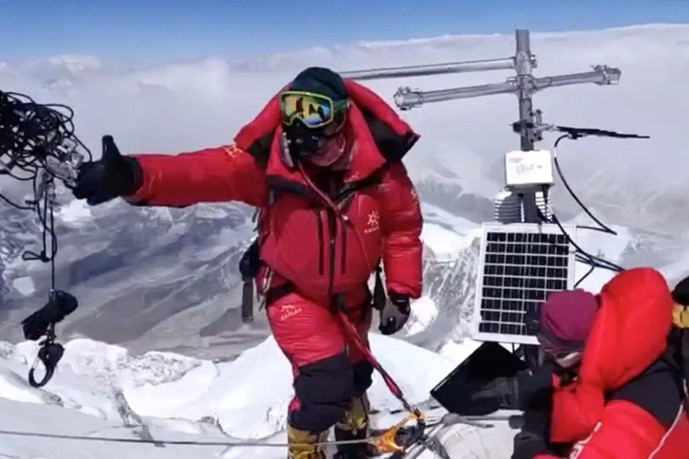
The new station, which sits at an altitude of 8,800 metres, replaces the Balcony Station, set up by American and British scientists, as the highest weather station on Earth. The Balcony Station, set up on Everest in 2019, sits at about 8,430 metres above sea level. The Qinghai-Tibet Plateau, where Mount Everest is located, is known as the roof of the world, the water tower of Asia and the Earth’s third pole. The Qinghai-Tibet Plateau was significant for various reasons, including as the origin of many important rivers in the world, and because its biodiversity resembled a “miniature landscape of the Earth”.
Source:
International Conference on Disaster Resilient Infrastructure
- Context: The Prime Minister has recently inaugurated the fourth edition of the International Conference on Disaster Resilient Infrastructure (ICDRI).
- ICDRI is the annual conference of the Coalition for Disaster Resilient Infrastructure (CDRI).
- It brings together member countries, organizations and institutions to strengthenthe global discourse on disaster and climate resilient infrastructure.
- The first edition took place in 2018 in New Delhi and the fourth edition is being organized in partnership with the US Government.
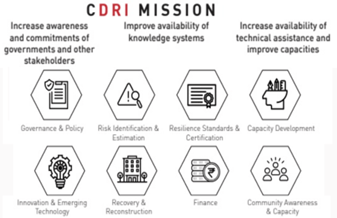
- The ICDRI will be an opportunity to address some of these questions and emphasize on resilience of transitioning infrastructure systems as a goal that is instrumental to realizing 1.50C climate adaptation for the most vulnerable, and attaining energy transition targets that integrate resilience.
- It will engage with decision-makers, practitioners and communities from across the world to discuss challenges, identify good practices, develop collaboration and galvanize concrete actions.
- ICDRI 2022 will include multi-sectoral and multi-country discussions and infrastructure transitions, risk governance and finance, innovation and human-centred, ecologically sensitive design for building resilience.
Source:
- Prime Minister addresses inaugural session of fourth edition of the International Conference on Disaster Resilient Infrastructure
- International Conference on Disaster Resilient Infrastructure
Image source:
Parshuram Jayanti
- Context: The Prime Minister has greeted the people on Parshuram Jayanti.
- Parashuram Jayanti is celebrated to honour the birth anniversary of Maharishi Parshuram, who is considered to be the 6th avatar of Lord Vishnu in the Hindu mythology.

- The sixth incarnation of Lord Vishnu, Lord Parshuram (literal meaning, Rama with an axe) is believed to have descended on earth to save it from the barbarity of the Kshatriyas.
- It falls on the third day of Shukla paksha in Baisakh according to the Hindu calendar and according to the Gregorian Calendar, it occurs in April or May.
- Parshuram Jayanti is also celebrated as Akshaya Tritiya in many parts of the country.
- The day is observed by fasting as a way of sacrificing the comforts of life in order to attain higher goals.
- It is also celebrated as an auspicious occasion to begin new endeavours and acquire new possessions such as starting a business or buying gold jewellery.
Source:
Image source:
Rupee Appreciation
- Context: The Indian rupee has recently appreciated six paise against the US dollar in the forex market.
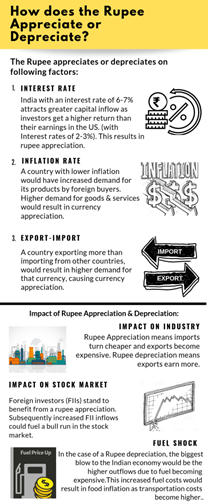
- Currency Appreciation is an increase in the value of one currency in relation to another.
- Appreciation of currency takes place when the supply of the currency is lesser than its demand in the foreign exchange market.
- If a Government sells sovereign bonds, it will lead top inflow of foreign capital (say in $); thus the supply of $ will increase leading to the appreciation of currency.
- On the other hand, currency depreciation is a fall in the value of a currencyin a floating exchange rate system.
- Rupee depreciation means that the rupee has become less valuable with respect to the dollar.
- It means that the rupee is now weaker than what it used to be earlier.
- For example: USD 1 that used to equal Indian Rs. 70, now equals Rs. 76,implying that the rupee has depreciated relative to the dollar i.e. it takes more rupees to purchase a dollar.
- The factors that contribute to rupee appreciation and depreciation are Inflation Rate, Employment Rate, Imports & Exports, Growth Rate, Interest Rates, Trade Deficit, Performance of the Equity Markets, Foreign Exchange Reserves, Foreign Investment Inflows etc.
Source:
- Currency: Rupee appreciates six paise at 76.43 against US dollar
- How does the Indian Rupee appreciate or depreciate?
Image source:
India’s first ethanol plant
- Context: Bihar has become the first state in the country to set up a greenfield grain-based ethanol production plant.
- It is the state's first ethanol production plant set up in Purnia district spread over an area of 15 acres.

- It is a 105 crore project that is expected to produce 65,000 litres of ethanol per day.
- The Purnia production plant will need 150 tons of maize and rice every day to produce the fuel which will be subsequently supplied to oil marketing companies for blending into petrol and later diesel.
- This initiative will enable the selling of the state’s agricultural produce at actual price fixed by the government than selling to local grain traders at cheap rates.
- It is also expected to reduce the cost of petrol and generate employment opportunities in the state.
Source:
- Bihar CM inaugurates India’s first ethanol plant in Purnia
- Bihar boasts of India's first greenfield grain-based ethanol plant
Image source:
Reducing the size of the Indian Army: ORF Online
Essence: The editorial debates the proposal of three-year Tour of Duty scheme whereby Indian Army looks at cutting down the work force, increase the tooth to tail ratio and curb high expenditures on armed forces by providing a short stint with the Indian Army to non-commissioned officers. Infusion of technology, automation, integration of forces will eventually lead to a leaner work force. However, opponents to this scheme say that shedding down the highly trained combatants after few years of service, at the prime of youth will lead to formation of unemployed trained militia, leading to more violent acts in the country. It would also undermine the slogan “naam, namak aur nishaan” and motivation to work especially by the martial communities which are preferred for the general recruitment as compared to the all-India recruitment. But there is no proof of the opinion that trained soldiers are trigger happy and the violence during independence movement was due to martial races, discounting other factors like disbanding the army and situation prevalent during those times.
Though the jawans could be parallelly mobilized and provide employment in the CAPF and state police cadres, it requires training and a smooth transition period. Government could also consider raising the duration of 3 years for the army service for optimal utilization of work force.
Why should you read this article?
- To know the issues presented against Tour of Duty scheme.
- To understand the need and necessity of making armed force a lean and flexible unit.
Source:
The real numbers of covid death: Indian Express
Essence: The editorial provides insight into the civil registration system and the covid deaths in the year 2020. Deaths are reported to the registrar of births and deaths by 3 lakh units spread throughout the country. Reporting of births and deaths provides certificates which are necessary for opening bank accounts, transfer of property registration, etc.
The 2020 CRS data speaks of 81 lakh deaths in India in 2020. 2019 saw 76 lakh deaths and 2018 saw 69 lakh deaths. The increase in number of deaths in 2020 could be attributed to covid situation or increase in registration at CRS portal and increase in population size of the country.
India has seen longer longevity leading to reduced mortality rate.
According to the editorial, India has seen 373 deaths per million due to covid, less than half of the world average of 804 and far lower than the developed nations US (3,052), UK (2,552), France (2,230), Sweden (1,835), Germany (1,613) and Canada (1,025). This shows India was successful in curtailing the covid deaths in the country.
Why should you read this article?
- To know the CRS data on death in the year 2020.
- To understand the perspective on increase in number of deaths and causes associated.
Source:
Possible undoing of Roe vs Wade in US will not just curtail right to abortion. It will signal a dangerous backsliding on hard-won freedoms: Indian Express
Essence: A leaked draft of the majority judgment of the United States Supreme Court in deciding legality of abortion suggests that it is going to overturn landmark Roe vs Wade judgment which made the right to abortion constitutional. It is important for people across the world because this landmark judgment of the US Supreme Court was a trailblazer in abortion rights. If this right will be compromised, it will raise questions of women’s right over their body and right to Privacy.
It is of particular significance for India because under the Indian Penal Code, 1860, abortion remains a criminal offence under Section 312. Medical Termination of Pregnancy (MTP) Act and its recent progressive amendment merely provides an exception to the criminalization. Whenever the US Supreme Court passes its final judgment on this matter, it should be mindful of the global impact its judgment will have on freedom of individuals and human rights.
Why should you read this article?
- To understand position of Indian laws on right to abortion.
- To appreciate globalization of ideas.
Source:
Beej Swaraj
Background
Tribal women in southern Rajasthan's Banswara region have used traditional wisdom to preserve indigenous seed varieties that are on the verge of extinction, re-establishing the link between agricultural diversity and climate resilience.
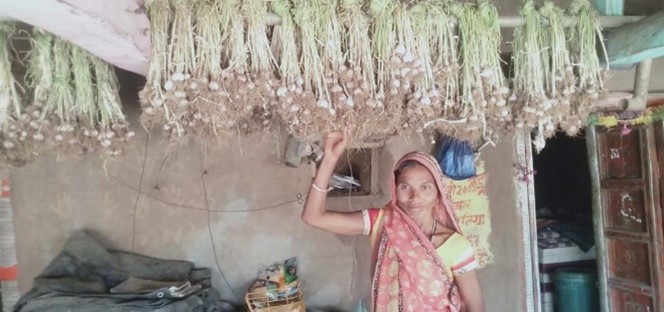
About Beej Swaraj
- A women's organisation known as "Saksham Samooh" has taken up seed preservation as a mission in the form of Beej Swaraj, or seed sovereignty, assisting tribal tribes with training and assistance.
- Saksham Samooh, based in Sangela village in Banswara district's Garhi tehsil, has used traditional ways to fill sacks with seeds, seal them, and store them in the granary for the next agricultural season.
- To obtain vegetable seeds, women let the veggies to ripen and then allow them to dry before separating the seeds and storing them.
- Vaagdhara, a tribal livelihood organisation located in Banswara, has raised awareness among tribal people about the importance of indigenous seeds.
- The Beej Swaraj philosophy, which is based on agricultural management with indigenous resources, would be successful in maintaining an appropriate health status for the tribal population.
- In addition to adopting seed-saving techniques, tribal women have been holding seed swapping events to meet the need for climate-resilient seeds and to prepare farmers for an emergency situation.
Quote: “A reasonable agriculture would do its best to emulate nature. Rather than change the earth to suit a crop it would diversify its crops to suit the earth.”- Verlyn Klinkenborg.
Source:
Share the article
Get Latest Updates on Offers, Event dates, and free Mentorship sessions.

Get in touch with our Expert Academic Counsellors 👋
FAQs
UPSC Daily Current Affairs focuses on learning current events on a daily basis. An aspirant needs to study regular and updated information about current events, news, and relevant topics that are important for UPSC aspirants. It covers national and international affairs, government policies, socio-economic issues, science and technology advancements, and more.
UPSC Daily Current Affairs provides aspirants with a concise and comprehensive overview of the latest happenings and developments across various fields. It helps aspirants stay updated with current affairs and provides them with valuable insights and analysis, which are essential for answering questions in the UPSC examinations. It enhances their knowledge, analytical skills, and ability to connect current affairs with the UPSC syllabus.
UPSC Daily Current Affairs covers a wide range of topics, including politics, economics, science and technology, environment, social issues, governance, international relations, and more. It offers news summaries, in-depth analyses, editorials, opinion pieces, and relevant study materials. It also provides practice questions and quizzes to help aspirants test their understanding of current affairs.
Edukemy's UPSC Daily Current Affairs can be accessed through:
- UPSC Daily Current Affairs can be accessed through Current Affairs tab at the top of the Main Page of Edukemy.
- Edukemy Mobile app: The Daily Current Affairs can also be access through Edukemy Mobile App.
- Social media: Follow Edukemy’s official social media accounts or pages that provide UPSC Daily Current Affairs updates, including Facebook, Twitter, or Telegram channels.





